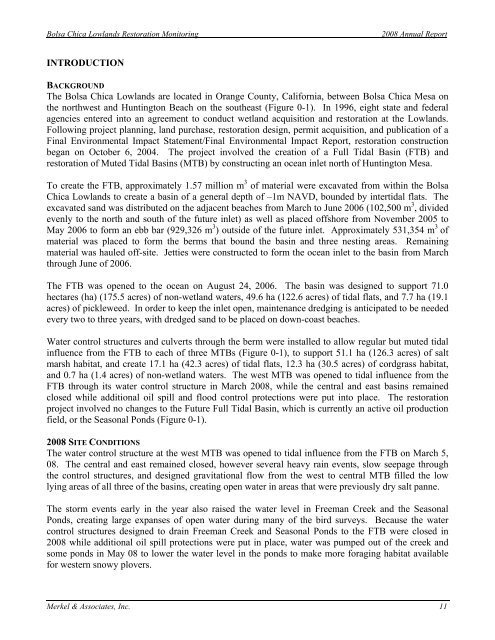2008 Annual Monitoring Report (pdf 10.9MB) - Bolsa Chica ...
2008 Annual Monitoring Report (pdf 10.9MB) - Bolsa Chica ...
2008 Annual Monitoring Report (pdf 10.9MB) - Bolsa Chica ...
Create successful ePaper yourself
Turn your PDF publications into a flip-book with our unique Google optimized e-Paper software.
<strong>Bolsa</strong> <strong>Chica</strong> Lowlands Restoration <strong>Monitoring</strong><br />
<strong>2008</strong> <strong>Annual</strong> <strong>Report</strong><br />
INTRODUCTION<br />
BACKGROUND<br />
The <strong>Bolsa</strong> <strong>Chica</strong> Lowlands are located in Orange County, California, between <strong>Bolsa</strong> <strong>Chica</strong> Mesa on<br />
the northwest and Huntington Beach on the southeast (Figure 0-1). In 1996, eight state and federal<br />
agencies entered into an agreement to conduct wetland acquisition and restoration at the Lowlands.<br />
Following project planning, land purchase, restoration design, permit acquisition, and publication of a<br />
Final Environmental Impact Statement/Final Environmental Impact <strong>Report</strong>, restoration construction<br />
began on October 6, 2004. The project involved the creation of a Full Tidal Basin (FTB) and<br />
restoration of Muted Tidal Basins (MTB) by constructing an ocean inlet north of Huntington Mesa.<br />
To create the FTB, approximately 1.57 million m 3 of material were excavated from within the <strong>Bolsa</strong><br />
<strong>Chica</strong> Lowlands to create a basin of a general depth of –1m NAVD, bounded by intertidal flats. The<br />
excavated sand was distributed on the adjacent beaches from March to June 2006 (102,500 m 3 , divided<br />
evenly to the north and south of the future inlet) as well as placed offshore from November 2005 to<br />
May 2006 to form an ebb bar (929,326 m 3 ) outside of the future inlet. Approximately 531,354 m 3 of<br />
material was placed to form the berms that bound the basin and three nesting areas. Remaining<br />
material was hauled off-site. Jetties were constructed to form the ocean inlet to the basin from March<br />
through June of 2006.<br />
The FTB was opened to the ocean on August 24, 2006. The basin was designed to support 71.0<br />
hectares (ha) (175.5 acres) of non-wetland waters, 49.6 ha (122.6 acres) of tidal flats, and 7.7 ha (19.1<br />
acres) of pickleweed. In order to keep the inlet open, maintenance dredging is anticipated to be needed<br />
every two to three years, with dredged sand to be placed on down-coast beaches.<br />
Water control structures and culverts through the berm were installed to allow regular but muted tidal<br />
influence from the FTB to each of three MTBs (Figure 0-1), to support 51.1 ha (126.3 acres) of salt<br />
marsh habitat, and create 17.1 ha (42.3 acres) of tidal flats, 12.3 ha (30.5 acres) of cordgrass habitat,<br />
and 0.7 ha (1.4 acres) of non-wetland waters. The west MTB was opened to tidal influence from the<br />
FTB through its water control structure in March <strong>2008</strong>, while the central and east basins remained<br />
closed while additional oil spill and flood control protections were put into place. The restoration<br />
project involved no changes to the Future Full Tidal Basin, which is currently an active oil production<br />
field, or the Seasonal Ponds (Figure 0-1).<br />
<strong>2008</strong> SITE CONDITIONS<br />
The water control structure at the west MTB was opened to tidal influence from the FTB on March 5,<br />
08. The central and east remained closed, however several heavy rain events, slow seepage through<br />
the control structures, and designed gravitational flow from the west to central MTB filled the low<br />
lying areas of all three of the basins, creating open water in areas that were previously dry salt panne.<br />
The storm events early in the year also raised the water level in Freeman Creek and the Seasonal<br />
Ponds, creating large expanses of open water during many of the bird surveys. Because the water<br />
control structures designed to drain Freeman Creek and Seasonal Ponds to the FTB were closed in<br />
<strong>2008</strong> while additional oil spill protections were put in place, water was pumped out of the creek and<br />
some ponds in May 08 to lower the water level in the ponds to make more foraging habitat available<br />
for western snowy plovers.<br />
Merkel & Associates, Inc. 11






